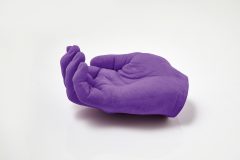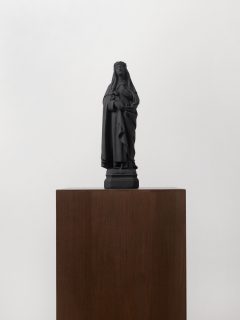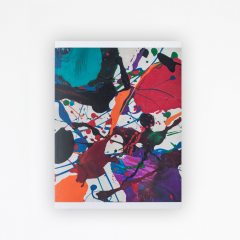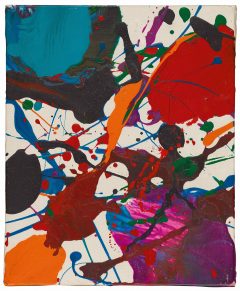Katharina Fritsch
Bettlerhand (Beggars hand)
2007

Plastic and paint
9.3 × 17 × 11 cm / 3 11/16 × 6 11/16 × 4 5/16 in
Signed, dated and numbered »4/24« on the accompanying certificate
Edition of 24 + 4 AP, Editor: fiftyfifty, Dusseldorf
Price includes German VAT. Shipping costs are not included. All prices are subject to change and availability. Change region and currency
fiftyfifty Galerie, Dusseldorf; Private Collection North Rhine-Westphalia
- Galerie Ludorff, "Neuerwerbungen Herbst 2020". Düsseldorf 2020
- Galerie Ludorff, "Neuerwerbungen Herbst 2020", Düsseldorf 2020, S. 28
The sculptor and installation artist Katharina Fritsch studied at the art academies in Münster and Düsseldorf and has held a professorship in sculpture at the latter since 2010.
Free from a sculptural signature, Fritsch creates sculptures based on polyester casts, which she covers with matt monochrome colours of high luminosity and perfect colour application. The figures vary in size from miniature to larger than life and can be found in international museums as well as in public spaces. In her works, Fritsch combines the industrial idea of serial production, characterised by Pop Art, with motifs borrowed from everyday life or religion, mythology or folklore, which often seem very familiar to us. Through their contrasting interplay of sheer colour effect, striking simplification and subliminally provocative choice of motif, her works challenge the viewer's everyday perception. They challenge us to distinguish between the familiarity of recognisable vision and an autonomous, immediatised reality.
Our works "Maus" (1991/1998) and "Bettlerhand" (2007) bring concrete images to the viewer's mind. However, through the colour alienation they lose their individual character and appear like enigmatic artefacts which, despite their captivating effect, defy precise definition. Fritsch invites the viewer to engage longer and more intensively with the objects, their associations and connotations. The severed hand is reminiscent of the severing of the hand as a punishment for theft and begging in the Middle Ages. Fritsch has also deliberately dyed it an intense purple, the colour that is considered the colour of penance in the Christian liturgy. The artist thus also reminds us that begging needy people was still a criminal offence in Germany until 1974.
It is the balancing act between representation and displacement that throws the viewer back to the essence of what is visible. Ultimately, the artist's greatest concern is to show the clarity of things themselves. To this end, she uses precision in representation as an instrument, which in her opinion equates to the greatest possible attention that can be paid to things.1)
1) "Katharina Fritsch in an interview with Marie Luise Syring and Christiane Vielhaber", in: BINATIONALE: Deutsche Kunst der späten 80er Jahre, exhib. cat. Städtische Kunsthalle, Kunstsammlung Nordrhein-Westfalen, Kunstverein für die Rheinlande und Westfalen, Düsseldorf, Cologne 1988, p. 117.





